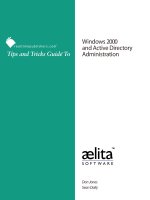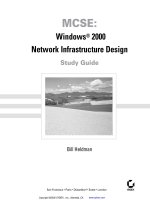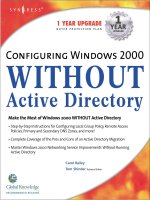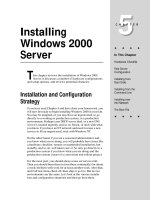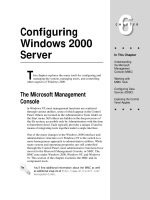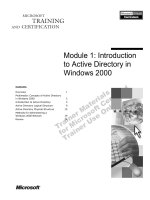Tài liệu Configuring Windows 2000 WITHOUT Active Directory pptx
Bạn đang xem bản rút gọn của tài liệu. Xem và tải ngay bản đầy đủ của tài liệu tại đây (10.96 MB, 786 trang )
1 YEAR UPGRADE
BUYER PROTECTION PLAN
WITHOUT
Active Directory
Configuring Windows 2000
Carol Bailey
Tom Shinder
Technical Editor
Make the Most of Windows 2000 WITHOUT Active Directory
• Step-by-Step Instructions for Configuring Local Group Policy, Remote Access
Policies, Primary and Secondary DNS Zones, and more!
• Complete Coverage of the Pros and Cons of an Active Directory Migration
• Master Windows 2000 Networking Service Improvements Without Running
Active Directory
147_noAD_FC 9/19/01 10:35 AM Page 1
With more than 1,500,000 copies of our MCSE, MCSD, CompTIA, and Cisco
study guides in print, we continue to look for ways we can better serve the
information needs of our readers. One way we do that is by listening.
Readers like yourself have been telling us they want an Internet-based ser-
vice that would extend and enhance the value of our books. Based on
reader feedback and our own strategic plan, we have created a Web site
that we hope will exceed your expectations.
is an interactive treasure trove of useful infor-
mation focusing on our book topics and related technologies. The site
offers the following features:
■
One-year warranty against content obsolescence due to vendor
product upgrades. You can access online updates for any affected
chapters.
■
“Ask the Author”™ customer query forms that enable you to post
questions to our authors and editors.
■
Exclusive monthly mailings in which our experts provide answers to
reader queries and clear explanations of complex material.
■
Regularly updated links to sites specially selected by our editors for
readers desiring additional reliable information on key topics.
Best of all, the book you’re now holding is your key to this amazing site.
Just go to www.syngress.com/solutions, and keep this book handy when
you register to verify your purchase.
Thank you for giving us the opportunity to serve your needs. And be sure
to let us know if there’s anything else we can do to help you get the
maximum value from your investment. We’re listening.
www.syngress.com/solutions
147_noAD_FM 8/10/01 3:13 PM Page i
147_noAD_FM 8/10/01 3:13 PM Page ii
1 YEAR UPGRADE
BUYER PROTECTION PLAN
WITHOUT
Active Directory
Configuring Windows 2000
Carol Bailey
Dr. Thomas W. Shinder
Technical Editor
147_noAD_FM 8/10/01 3:13 PM Page iii
Syngress Publishing, Inc., the author(s), and any person or firm involved in the writing, editing, or production
(collectively “Makers”) of this book (“the Work”) do not guarantee or warrant the results to be obtained from
the Work.
There is no guarantee of any kind, expressed or implied, regarding the Work or its contents.The Work is sold
AS IS and WITHOUT WARRANTY.You may have other legal rights, which vary from state to state.
In no event will Makers be liable to you for damages, including any loss of profits, lost savings, or other inci-
dental or consequential damages arising out from the Work or its contents. Because some states do not allow
the exclusion or limitation of liability for consequential or incidental damages, the above limitation may not
apply to you.
You should always use reasonable case, including backup and other appropriate precautions, when working
with computers, networks, data, and files.
Syngress Media®, Syngress®, and “Career Advancement Through Skill Enhancement®,”are registered trademarks
of Syngress Media, Inc. “Ask the Author™,”“Ask the Author UPDATE™,”“Mission Critical™,”“Hack
Proofing™,” and “The Only Way to Stop a Hacker is to Think Like One™” are trademarks of Syngress
Publishing, Inc. Brands and product names mentioned in this book are trademarks or service marks of their
respective companies.
KEY SERIAL NUMBER
001 MKE783FV2P
002 BH8UZ237VB
003 DNVN5T5QL9
004 JDKJR4PP9D
005 ZLA99G2FLW
006 234UFVKLMA
007 94JGV3MDK2
008 FKA3234KP3
009 J3AWV4MLSD
010 NK3VL8SE4N
PUBLISHED BY
Syngress Publishing, Inc.
800 Hingham Street
Rockland, MA 02370
Configuring Windows 2000 Without Active Directory
Copyright © 2001 by Syngress Publishing, Inc. All rights reserved. Printed in the United States of America.
Except as permitted under the Copyright Act of 1976, no part of this publication may be reproduced or
distributed in any form or by any means, or stored in a database or retrieval system, without the prior written
permission of the publisher, with the exception that the program listings may be entered, stored, and executed
in a computer system, but they may not be reproduced for publication.
Printed in the United States of America
1 2 3 4 5 6 7 8 9 0
ISBN: 1-928994-54-7
Technical Editor: Dr.Thomas W. Shinder Cover Designer: Michael Kavish
Co-Publisher: Richard Kristof Page Layout and Art by: Shannon Tozier
Acquisitions Editor: Catherine B. Nolan Copyedit by Syngress Editorial Team
Developmental Editor: Jonathan Babcock Indexer: Julie Kawabata
Freelance Editorial Manager: Maribeth Corona-Evans
Distributed by Publishers Group West in the United States and Jaguar Book Group in Canada.
147_noAD_FM 8/10/01 3:13 PM Page iv
v
Acknowledgments
v
We would like to acknowledge the following people for their kindness and support
in making this book possible.
Richard Kristof and Duncan Anderson of Global Knowledge, for their generous
access to the IT industry’s best courses, instructors, and training facilities.
Ralph Troupe, Rhonda St. John, and the team at Callisma for their invaluable insight
into the challenges of designing, deploying and supporting world-class enterprise
networks.
Karen Cross, Lance Tilford, Meaghan Cunningham, Kim Wylie, Harry Kirchner,
Kevin Votel, Kent Anderson, and Frida Yara of Publishers Group West for sharing
their incredible marketing experience and expertise.
Mary Ging, Caroline Hird, Simon Beale, Caroline Wheeler,Victoria Fuller, Jonathan
Bunkell, and Klaus Beran of Harcourt International for making certain that our
vision remains worldwide in scope.
Anneke Baeten and Annabel Dent of Harcourt Australia for all their help.
David Buckland,Wendi Wong, Daniel Loh, Marie Chieng, Lucy Chong, Leslie Lim,
Audrey Gan, and Joseph Chan of Transquest Publishers for the enthusiasm with
which they receive our books.
Kwon Sung June at Acorn Publishing for his support.
Ethan Atkin at Cranbury International for his help in expanding the
Syngress program.
147_noAD_FM 8/10/01 3:13 PM Page v
147_noAD_FM 8/10/01 3:13 PM Page vi
vii
Author
Carol Bailey (MCSE+Internet) is a Senior Technical Consultant
working for Metascybe Systems Ltd in London. Metascybe is a Microsoft
Certified Partner that develops its own PC communications software as
well as offers project work and consultancy. In addition to supporting
these products and services for an internationally diverse customer base,
Carol co-administers the company’s in-house IT resources.
With over 10 years in the industry, Carol has accumulated a wealth of
knowledge and experience with Microsoft operating systems. She first
qualified as an MCP with NT3.51 in 1995 and will remain qualified as
MCSE as a result of passing the Windows 2000 exams last year. Her
other qualifications include a BA (Hons) in English and an MSc in
Information Systems.
Well known for her Windows 2000 expertise, Carol has a number of
publications on this subject, which include co-authoring the following
books in the best-selling certification series from Syngress\Osborne
McGraw-Hill: MCSE Windows 2000 Network Administration Study Guide
(Exam 70-216). ISBN: 0-07-212383-4; MCSE Designing a Windows 2000
Network Infrastructure Study Guide (Exam 70-221). ISBN: 0-07-212494-6;
and MCSE Windows 2000 Accelerated Boxed Set (Exam 70-240).
ISBN: 0-07-212383-4.
147_noAD_FM 8/10/01 3:13 PM Page vii
viii
Technical Editor
Thomas Shinder, M.D.
(MCSE, MCP+I, MCT) is a technology
trainer and consultant in the Dallas-Ft.Worth metroplex. He has con-
sulted with major firms, including Xerox, Lucent Technologies, and FINA
Oil, assisting in the development and implementation of IP-based com-
munications strategies.Tom is a Windows 2000 editor for Brainbuzz.com
and a Windows 2000 columnist for Swynk.com.
Tom attended medical school at the University of Illinois in Chicago
and trained in neurology at the Oregon Health Sciences Center in
Portland, Oregon. His fascination with interneuronal communication ulti-
mately melded with his interest in internetworking and led him to focus
on systems engineering.Tom and his wife, Debra Littlejohn Shinder,
design elegant and cost-efficient solutions for small- and medium-sized
businesses based on Windows NT/2000 platforms.Tom has authored
several Syngress books, including Configuring ISA Server 2000: Building
Firewalls for Windows 2000 (ISBN: 1-928994-29-6), Configuring Windows
2000 Server Security (ISBN: 1-928994-02-4), Managing Windows 2000
Network Services (ISBN: 1-928994-06-7), and Troubleshooting Windows 2000
TCP/IP (ISBN: 1-928994-11-3).
147_noAD_FM 8/10/01 3:13 PM Page viii
Contents
ix
Foreword xxv
Chapter 1 Why Not Active Directory? 1
Introduction 2
Why Use Windows 2000 without
Active Directory? 2
Why Use Windows 2000? 2
The Acceptance of Windows into the
Corporate Workplace 3
The Acceptance of Microsoft in the
Corporate Workplace 3
The Emergence of Windows 2000 4
Windows 2000 Track Record 5
Windows 2000 Today 5
Why Not Use Active Directory? 6
Designing and Deploying Active
Directory: More Than a Technical
Challenge 7
The Purpose of This Book 9
Who Should Read This Book 11
IT Managers 11
IT Implementers 11
What This Book Will Cover 13
Chapter 2:Workstations 13
Chapter 3: Laptops 14
Chapter 4: File and Print Services 15
Chapter 5:Terminal Services 15
Why Use Windows
2000 without Active
Directory?
There is more to Windows
2000 than just Active
Directory features—as this
book shows. But there’s
no doubt that Windows
2000 was written with
Active Directory in mind,
which is reflected in the
standard documentation
that accompanies the
software. Chapter 1 will
begin to answer these
questions.
147_noAD_TOC 8/10/01 12:24 PM Page ix
x Contents
Chapter 6: Networking Services—
DNS, DHCP,WINS, NLB 16
Chapter 7: Internet Services—
IIS5 and Certificate Services 17
Chapter 8: Secure Communication—IPSec 18
Chapter 9: Remote Access—
RAS,VPN, IAS, and CMAK 18
Chapter 10: Internet Connectivity—
ICS, NAT, and ISA Server 19
Appendix A:The Windows 2000
Microsoft Management Console 20
What This Book Won’t Cover 21
Exchange 2000 and Other Active
Directory Dependent Applications 22
Intellimirror Features 25
Enterprise Related Group Policy
Objects 28
Quick Resource Searches across the
Enterprise Network, with the Ability to
Extend the Schema 29
Universal Groups, Group Nesting,
and Changes in Group Membership 32
Task Delegation 33
Kerberos Rather Than NTLM
Authentication 34
Automatic Transitive Trusts 35
Multimaster Domain Controllers 36
Enterprise Encrypting File System (EFS)
Recovery Agents 38
Enterprise Certificate Authorities 39
Quality of Service 40
Active Directory Integration 43
Migrating Networks 45
Fractional Networks 46
Dangers of Fractional Networks
Running Active Directory 47
External Networks 47
147_noAD_TOC 8/10/01 12:24 PM Page x
Contents xi
Walkthrough: Managing User Accounts
and Securing the Local Administrator Account 49
Summary 56
Solutions Fast Track 57
Frequently Asked Questions 59
Chapter 2 Workstations 65
Introduction 66
Using Local Group Policy 67
Group Policy Objects 69
Locating Local Group Policy 70
Local Security Policy 71
Complete Local Group Policy Settings 71
Configuring Local Group Policy 73
Useful Group Policy Objects 75
Computer Startup/Shutdown
and User Logon/Logoff Scripts 76
Password Options 77
Internet Explorer Settings 81
Disabling Installation from Removable
Media 81
Controlling Access to Control Panel
and Components 81
Screen Saver Options 83
Disabling the Command Prompt,
Disabling the Registry Editor, Running
Only Specified Windows Applications 83
Deploying Local Group Policy Objects 84
Security Configuration Using Templates 84
Security Templates 85
Default Security Template 87
Secure Security Template 87
Highly Secure Template 87
Compatible Template 88
Out of the Box Templates 88
Viewing and Modifying Templates 88
Viewing Template Settings 88
TIP
You can always check
the current version of
Windows (build and
Service Pack if
applied) by running
WinVer.exe, which
displays the About
Windows dialog box.
147_noAD_TOC 8/10/01 12:24 PM Page xi
xii Contents
Modifying Template Settings 91
Applying Templates 91
Security Configuration and Analysis 92
Configure Computer Now 92
Analyze Computer Now 94
Deploying Security Templates Automatically
with Secedit 95
Secedit /Configure Options 95
Improvements in System Reliability 96
Device Driver Signing 97
Driver Signing Options 98
Driver Signing Verification 98
Windows File Protection and
System File Checker 99
How Windows File Protection and
System File Checker Work 100
WFP Configuration Options 102
WFP Limitations 104
Service Pack Application 105
Slip-Streaming Service Packs 105
Limitations of Service Packs 106
Improvements in Usability 107
Desktop Changes 108
Personalized Menus 109
Start Menu Settings 109
Display Options 111
Folder Options 112
Hardware Support 113
Wizards and Help 114
Wizards 114
Help 116
Walkthrough: Configuring Local Group Policy 119
Summary 122
Solutions Fast Track 123
Frequently Asked Questions 125
147_noAD_TOC 8/10/01 12:24 PM Page xii
Contents xiii
Chapter 3 Laptops 129
Introduction 130
Integrating Mobile Computing with the
Corporate Network 131
Switching between Working Environments 133
Power Management and Preservation 133
Offline Files and
Synchronizing Data 140
Dialup Access 151
Securing Data Outside the Company
Environment 153
Encrypting Folders and Files 155
Limitations and Considerations when
Using EFS 156
Disabling EFS 156
Remote Access Security 158
Mobile Maintenance and Troubleshooting 158
Safe Mode and the Recovery Console 159
Using the Recovery Console 163
Task Scheduler 165
Configuring Scheduled Tasks 166
Task Manager 168
Walkthrough: Using Offline Files 172
Summary 176
Solutions Fast Track 178
Frequently Asked Questions 180
Chapter 4 File and Print Services 185
Introduction 186
Sharing Data: Storing and Retrieving 187
Distributed File System (DFS) 191
Configuring Dfs 194
Volume Mount Points 197
Configuring Mounted Drives 199
Indexing Service 200
Configuring Index Catalogs 204
Switching between
Working Environments
There are a number of
features that help users
switch seamlessly between
their different working
environments. These
include:
■
Power management
and preservation
■
Offline folders and
synchronizing data
■
Dialup access
147_noAD_TOC 8/10/01 12:24 PM Page xiii
xiv Contents
Sharing Printers: Installing and Managing 207
Standard TCP/IP Port Monitor 210
IP Printing 210
Printing Permissions Over the Internet 214
Better Monitoring 214
User Options 216
Managing Servers 216
Disk Management 217
Using the Disk Management Utility 220
Data Management 222
Remote Storage 222
Windows 2000 Backup Utility 224
Disk Quotas 225
Configuring Disk Quotas 226
Monitoring 229
Counter Logs 232
Alerts 232
Trace Logs 233
Using Performance Data 233
Auditing Events and the Security Log 234
Auditing the Registry 236
Auditing Administrative Actions 237
Configuring Counter and Alert Logs 238
Configuring and Using the Event Logs 240
Walkthrough: Setting an Audit Policy 244
Summary 252
Solutions Fast Track 253
Frequently Asked Questions 256
Chapter 5 Terminal Services 261
Introduction 262
Why Use Windows 2000 Terminal Services? 263
Fast Connections Over Low Bandwidths 264
Remote Administration 265
Remote Administration Using
Terminal Services 266
NOTE
The general advice
when planning disk
space for indexing is
to allow at least 30
percent and prefer-
ably 40 percent of
the total amount of
disk space you index
(known as the
corpus). It would
also be prudent to
host the index cata-
logs on a different
disk from the
operating system.
147_noAD_TOC 8/10/01 12:24 PM Page xiv
Contents xv
Terminal Services Remote Management
Limitations 267
Recovering from Disconnected Sessions 269
Tighter Security 270
Using the Application Security Tool 274
Shadowing Users 276
Seamless Integration Between PC and Server 278
Clipboard Copy and Paste 279
Drive Mappings 280
Local Printer Support 280
Profiles 281
Home Directories 282
Multilanguage Support 283
Preinstallation Considerations 283
Licensing 284
Installing Terminal Services Licensing 286
How Terminal Service Licensing Works 288
Activating a Terminal Services License
Server 290
Upgrading from TSE 293
Unattended Installations 295
Application Suitability 295
Capacity and Scaling 298
Limitations 301
Configuring and Managing Windows 2000
Terminal Services 302
Configuring Clients to Use Terminal Services 308
Terminal Services Client 308
Terminal Services Advanced Client 314
Automating Terminal Services Client
Setup 317
Using TSAC as a Diagnostic Utility 319
Walkthrough: Remotely Administering a
Windows 2000 Server With Terminal Services 321
Summary 327
Solutions Fast Track 329
Frequently Asked Questions 332
Understand the
specific technical
features and options
available with
Windows 2000
Terminal Services,
including:
■
Fast connections over
low bandwidths
■
Remote
administration
■
Tighter security
■
Shadowing (remote
control)
■
Seamless integration
between PC and
server
147_noAD_TOC 8/10/01 12:24 PM Page xv
xvi Contents
Chapter 6 Networking Services 337
Introduction 338
Name Resolution with DNS 340
Do You Need to Run DNS? 340
Advantages of Microsoft’s Windows 2000
DNS 344
Dynamic Updates 345
WINS Integration 347
Service Records 349
Unicode and the Underscore 352
Incremental Transfers 355
Easy to Use GUI Administration 356
Integrating Microsoft DNS and UNIX DNS 357
Server Roles and Zones 357
Transferring Zones 360
Importing Zone Files 361
DHCP for Central Configuration and Control
of Addresses 363
TCP/IP Configuration Options 366
Vendor and User Class Options 367
BOOTP and Multicast Scopes 368
Automatic Private IP Addressing (APIPA) 370
Superscopes 371
Multinets 372
Server Consolidation 373
Migrating Users from One Scope to
Another (Address Reallocation) 374
Name Resolution with WINS 375
Improved WINS Manager 380
Data Integrity 381
Backup Policy 383
Controlling Replication Partners 383
Replication Policy 383
Removing Old Mappings 384
Database Verification 385
Justifications for
running DNS include:
■
Having UNIX
computers
■
Running Internet
services
■
Running Active
Directory
■
Preparing for Active
Directory
■
Looking to integrate
UNIX and Microsoft
communication
147_noAD_TOC 8/10/01 12:24 PM Page xvi
Contents xvii
High Performance 386
Burst Mode Handling 386
Persistent Connections 386
High Availability with Network Load
Balancing (NLB) 388
Network Load Balancing Components 392
Addresses and Priorities 393
Port Rules 395
The WLBS Command Line Utility 398
Configuring Network Load Balancing 399
Configuring Cluster Parameters 400
Configuring Host Parameters 402
Configuring Port Rules 402
Monitoring and Administering Network
Load Balancing 405
Walkthrough: Configuring DNS Primary and
Secondary Zones 407
Summary 413
Solutions Fast Track 414
Frequently Asked Questions 418
Chapter 7 Internet Services 423
Introduction 424
Installing IIS5 425
Improvements in Reliability 427
Application Protection 427
Setting Application Protection 428
IISreset 429
Restarting IIS from the Internet
Information Services Snap-In 429
Restarting IIS Using the Command Line 429
Additional Control When Stopping
IIS Services 430
Backup/Restore Configuration 431
Limitations of Backup/Restore
Configuration 433
NOTE
Internet Explorer 3.0,
Netscape Navigator
2.0, and later ver-
sions of both
browsers support the
use of host header
names. Older
browsers do not.
Additionally, you
cannot use host
headers with SSL
because the host
header will be
encrypted—this is an
important point for
Web servers using
SSL for additional
security.
147_noAD_TOC 8/10/01 12:24 PM Page xvii
xviii Contents
FTP Restart 433
Limitations of FTP Restart 433
Improvements in Administration and
Management 434
Wizards and Tools 435
Security Settings Permission Wizard 435
Windows 2000 Internet Server Security
Configuration Tool 437
Certificate Wizard and Certificate
Trust Lists Wizard 438
IIS Migration Wizard 440
Improved Logging for Process Accounting 440
Improved Remote Administration 441
Web Site Operators 443
Improvements in Security 444
Windows Integrated 446
Digest 446
Fortezza 447
Improvements in Performance 447
HTTP Compression 448
Configuring HTTP Compression 449
ASP Improvements 451
Bandwidth Throttling 452
Configuring Bandwidth Throttling 452
Process Throttling 453
Socket Pooling 454
Document Collaboration with WebDAV 455
Using WebDAV 456
Certificate Services 458
Certificate Authorities and Roles 459
Installing and Configuring a Standalone CA 461
Server Certificates 462
Installing the Web Server’s Certificate
Offline with a Standalone CA 463
How Users Request and Manage Certificates 465
147_noAD_TOC 8/10/01 12:24 PM Page xviii
Contents xix
Using Secure Communication (SSL) on the
Web Server 468
Client Certificate Mapping 469
Configuring One-to-One Account
Mappings 470
Configuring Many-to-One Account
Mappings 472
Walkthrough: Configuring Multiple Web Sites
on a Single Web Server 474
Summary 483
Solutions Fast Track 484
Frequently Asked Questions 488
Chapter 8 Secure Communication 491
Introduction 492
IPSec Planning—Working Out What You Want
to Secure and How 493
Password Based 496
Certificate Based 497
IP Security Utilities—For Configuring and
Monitoring Secure Communication 498
Using IP Security Policies on Local
Machines 499
Using IP Security Monitor 500
Using the IPSec Policy Agent Service 502
Using TCP/IP | Advanced | Options 503
Using Certificates Snap-In 504
Using the Security Log 505
Using the NetDiag Support Tool 507
IPSec Built-in Policies—For Minimal
Administrator Configuration 508
Client (Respond Only) 509
Server (Request Security) 510
Secure Server (Require Security) 510
IPSec Policy Components 511
IP Filter Rules and Lists 511
Secure communication
can be broken down
into the following five
components:
■
Nonrepudiation
■
Antireplay
■
Integrity
■
Confidentiality
■
Authentication
147_noAD_TOC 8/10/01 12:24 PM Page xix
xx Contents
Recommendations for Defining Filter
Lists 514
IP Filter Actions 514
Recommendations for Defining Filter
Actions 516
Other IP Rule Components—
Authentication,Tunnel Setting, and
Connection Type 517
Setting Computer Authentication
Using Preshared Keys 518
Setting Authentication Using Certificates 518
IP Security Protocols and Algorithms 523
Data Authentication Algorithms 525
Data Encryption Algorithms 525
Key Exchange and Management 526
Configuring Session Key Settings 528
Security Associations 531
Walkthrough 8.1: Setting and Testing Custom
IPSec Policies 534
Walkthrough 8.2: Using IPSec
to Protect a Web Server 542
Summary 550
Solutions Fast Track 551
Frequently Asked Questions 554
Chapter 9 Remote Access 559
Introduction 560
Using and Configuring Remote Access Policies 561
Remote Access Administration Models 562
Granting Remote Access
Authorization—By User 564
Access by Policy on a Standalone Server
in a Workgroup 565
Access by Policy on a Member
Server in an NT4 Domain 566
Remote Access Policy Components 567
147_noAD_TOC 8/10/01 12:24 PM Page xx
Contents xxi
Configuring Windows 2000 Routing and
Remote Access 568
Configuring General Server Properties 570
Configuring Security Server Properties 570
Configuring IP Server Properties 572
Automatic Private IP Address 573
DHCP Address Allocation 573
TCP/IP Configuration Options 574
Configuring IPX Server Properties 577
Configuring NetBEUI Server Properties 577
Configuring PPP Server Properties 578
Configuring Event Logging Server
Properties 579
Configuring Dialup and VPN Connections 579
Configuring L2TP VPN Connections 582
Modifying the Default L2TP/IPSec
Policy 586
Using and Configuring Internet Authentication
Service (IAS) 590
Configuring RRAS and IAS 592
IAS Configuration with ISPs 595
Configuring Remote Clients with the
Connection Manager Administration Kit 598
Manually Defining Connections 600
Using the Connection Manager
Administration Kit 601
Preparation: Creating a Static Phone
Book 602
Preparation: Creating a Dynamic Phone
Book 605
Running the Connection Manager
Administration Kit 606
Refining Details 609
How Users Install and Use Connection
Manager 611
Setting the Tunneling
Value, Necessary for
L2TP/IPSec Support
VpnStrategy
Value Description
1 PPTP only
(the default)
2 Try PPTP
and then
L2TP/IPSec
3 L2TP/IPSec
only
4 Try L2TP/
IPSec and
the PPTP
(Windows
2000
default)
147_noAD_TOC 8/10/01 12:24 PM Page xxi
xxii Contents
Walkthrough: Configuring Remote Access
Policies 614
Summary 617
Solutions Fast Track 617
Frequently Asked Questions 620
Chapter 10 Internet Connectivity 625
Introduction 626
Using and Configuring Internet Connection
Sharing (ICS) 628
ICS Settings 630
Using and Configuring RRAS Network
Address Translation (NAT) 632
Installing NAT 633
Adding NAT to RRAS 635
Configuring NAT 637
Configuring Global NAT Properties 638
Configuring NAT Internet Interface
Properties 641
Monitoring NAT 642
Controlling Connections 645
Configuring Demand-Dial Restrictions 646
Configuring Internet Filters 647
Using and Configuring Internet Security
and Acceleration (ISA) Server 649
Security Features 653
Caching Features 658
Additional Features 660
Reporting Features 662
Bandwidth Priorities 663
Extensible Platform 663
ISA Clients 664
Web Proxy Client 665
SecureNAT Client 665
Firewall Clients 666
Upgrading Issues 667
Q:
I’m interested in
publishing a VPN
server behind the ISA
Server. I understand
IPSec can’t be
translated, but is there
a good reason why I
can’t run a PPTP server
on my internal
network configured as
a SecureNAT client?
A:
There is a good reason
why this won’t work—
the SecureNAT
element works only
with TCP and UDP
ports. PPTP uses the
GRE protocol (number
47) in addition to TCP
port 1723, and there’s
no way to translate
this when it comes
into the ISA server
from an external
client. You can create
VPN connections from
the internal network,
and you can run a VPN
server on the ISA
server itself or on a
DMZ, but you cannot
publish a VPN server
as a SecureNAT client.
147_noAD_TOC 8/10/01 12:24 PM Page xxii
Contents xxiii
Walkthrough: Configuring NAT to Publish a
Web Server 670
Summary 674
Solutions Fast Track 676
Frequently Asked Questions 679
Appendix The Windows 2000
Microsoft Management Console 683
Introduction 684
MMC Basics 684
Saving Configuration Changes 687
Exporting Information from MMC Snap-Ins 687
Adding Servers 688
Remote Administration 690
Command Line 690
Configuring and Creating Your Own MMCs 693
Using URL Links 695
Using Favorites in MMCs 696
Organizing Favorites 698
Saving Custom MMCs 699
Changing the Custom MMC View 702
Advanced MMC Configuration: Using Taskpads 703
The New Taskpad View Wizard 704
Adding Taskpad Views and Non-Snap-In
Commands 710
Further Customization and Development
with MMCs 711
Distributing MMCs 713
Summary 714
Index 715
Taskpad views are
HTLM pages that can
contain a number of
items:
■
MMC Favorites
■
Wizards
■
Scripts
■
Programs
■
URLs
147_noAD_TOC 8/10/01 12:24 PM Page xxiii
147_noAD_TOC 8/10/01 12:24 PM Page xxiv
